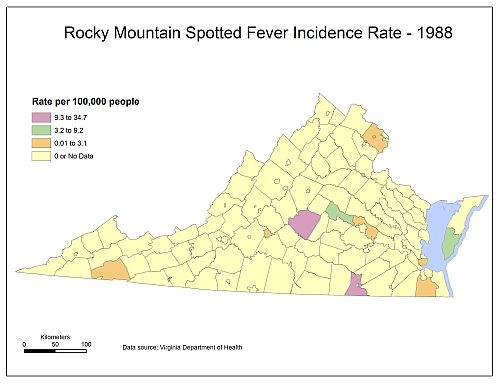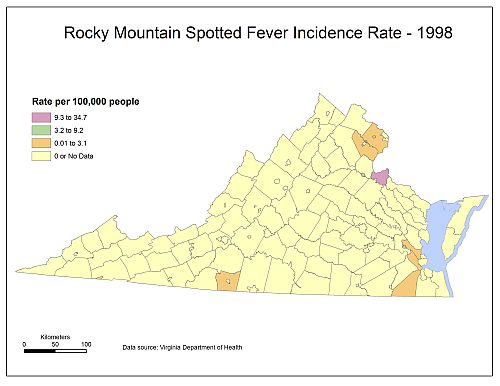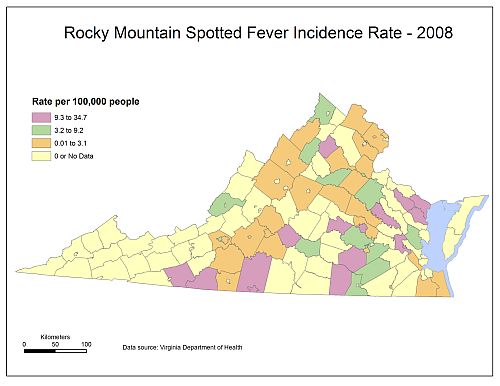Human Health and Safety
Climate–related factors which might influence the distribution of human diseases are:
- Air Temperature predicted to increase
- Precipitation predicted to change in intensity and pattern
- Water Temperature predicted to increase due to an increase in air temperature
There are a number of viruses and pathogens in the environment that can affect humans through transmission from insect vectors (e.g. mosquitoes, ticks) or through the food supply (e.g. shellfish). Since the vectors live within certain environmental parameters, they are susceptible to changes in climatic conditions. These changes may either increase or decrease their capacity to carry and transmit human diseases.
Some vector transmitted diseases of concern in Virginia are:
- Malaria from mosquitoes, but typically acquired overseas
- Arboviral Infections from mosquitoes, but may be carried to an area by migrating birds
- Blue-Green Algal Blooms from direct contact with water or by eating contaminated fish or crabs
- Ehrlichiosis from ticks, but related to populations of infected animals
- Lyme Disease from ticks, but related to populations of infected animals
- Vibrio Bacteria from oysters
- Rocky Mountain Spotted Fever from ticks, but related to populations of infected animals



Tick populations are linked both to seasonal variations (for their own population dynamics) and the presence of a host. The prevalence of a virus in the blood stream of a host species may be linked to temperature, with warmer temperatures resulting in a higher virus population within the host (Smith and Tirpak, 1989). Models of climate change indicate a northward shift in American Dog Tick populations with increases in CO2 (Haile 1989). Local deer populations provide food for ticks, allowing tick populations to establish and spread (Wu et al. 2010); the deer and mouse (another host) populations depend on acorn production, creating a link to mast production by oaks (Jones et al. 1998), which is also related to climatic factors.
Other potential relationships which could be affected by climate include:
Potential Relationships |
Data Available? |
Data Sets |
|
Impacts of air temperature/ precipitation changes on Lyme Disease? |
Yes |
US Historical Climatology Network (~1948-present), Virginia Department of Health (1979-present) |
| Impacts of water temperature changes on shellfish pathogens? | No |
Chesapeake Bay Program Water Quality Monitoring (1949-present) |
References:Haile, D.G. (1989) Computer simulation of the effects of changes in weather patterns on vector-borne disease transmission. In The potential effects of global climate change on the United States. Smith, J.B. and D.A.Tirpak, eds. Washington, D.C: U.S. Environmental Protection Agency, Office of Research and Development, Office of Policy, Planning and Evaluation. Jones, C., R. Ostfeld, M. Richard, E. Schauber and J. Wolff (1998) Chain Reactions Linking Acorns to Gypsy Moth Outbreaks and Lyme Disease Risk. Science, New Series, Vol. 279, No. 5353: pp. 1023-1026 Smith, J.B. and D.A.Tirpak, eds. (1989) Human health. Chapter 12 of The potential effects of global climate change on the United States. Washington, D.C: U.S. Environmental Protection Agency, Office of Research and Development, Office of Policy, Planning and Evaluation. Wu, X., V. Duvvuri and J. Wu (2010) Modeling dynamical temperature influence on tick Ixodes scapluaris population. In: David A. Swayne, Wanhong Yang, Alexey A. Voinov, Andrea Rizzoli, Tatiana Filatova, eds. Proceedings of the iEMSs Fourth Biennial Meeting: International Congress on Environmental Modelling and Software (iEMSs 2010). International Environmental Modelling and Software Society, Ottawa, Canada, July 2010. |

